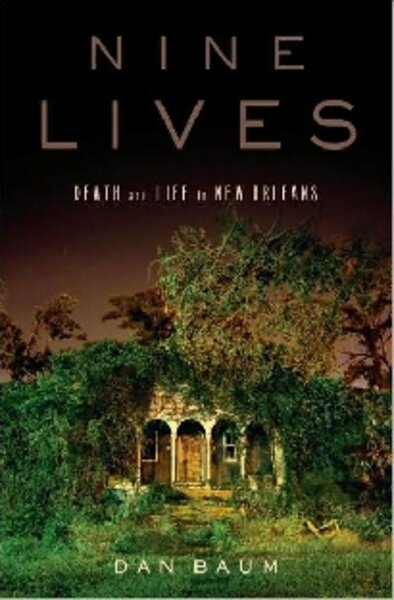Nine Lives: Death and Life in New Orleans
Loading...
“By almost any metric,” writes New Yorker correspondent Dan Baum, New Orleans is “the worst city in the United States.” It has “the deepest poverty, the most murders, the worst schools, the sickest economy, the most corrupt and brutal cops.”
And yet, when asked in a poll (taken shortly before hurricane Katrina), more New Orleanians said they were “extremely satisfied” with their lives than residents of any other American city.
Or, in the words of Big Easy resident Anthony Lewis (shortly after Katrina), “Always been [messed] up here, but it’s home.”
Lewis is just one of nine New Orleanians that Baum tracks in Nine Lives: Death and Life in New Orleans, a wonderful, deeply textured story of a metropolis so alien to the country in which it resides that it seems “a city-sized act of civil disobedience.” Through the eyes of his nine subjects, Baum follows the jaunty, chaotic flow of life in New Orleans from 1965 (just after the ruinous hurricane Betsy) up through and just beyond the devastation of Katrina in 2005.
Baum met his subjects while reporting on Katrina and its aftermath for the New Yorker. They are a remarkably disparate group – and definitely a body that could be assembled only in New Orleans.
They include a wealthy carnival king who lives in a Garden District mansion, a retired streetcar repairman with deep roots in the Lower Ninth Ward, and a transsexual pub owner. Some are local celebrities of greater or lesser proportion (the aristocratic jazz-playing parish coroner and the widow of a Mardi Gras Indian famed for his costumes). Others seem to simply blur into the fabric the city’s daily life (a white cop from Lakeview and a black convict from the Goose).
But taken together their narratives create a rich and tasty stew – the kind of hearty repast that requires generous infusions of excellent reporting. At the end of the book, Baum tallies the number of interviews he did, but for a reader it’s hard even to imagine the work that must have gone into a story with this sweep.
That sweat equity, however, really pays off. The result is a loving – albeit warts-and-all – portrait of New Orleans kaleidoscoped together through multiple viewpoints. Ronald Lewis (the streetcar repairman) opens the book with an idyllic vision of life in the bucolic Lower Ninth Ward of his childhood – a place where pigs foraged in backyards and the smell of fried bananas perfumed the air.
Wilbert Rawlins Jr. (a high school band leader), however, sees the city as a sea of teenagers living in poverty while their fathers sell the family TVs and PlayStations to buy drugs.
Billy Grace offers the perspective of a blue blood from the city’s finest district who cherishes its gilded traditions – and yet wonders why he must daily confront a level of poverty that his friends in other US cities can’t even imagine.
Tim Bruneau (the cop) views New Orleans as “one big misdemeanor lockup” and worries that “sooner or later, a city this slovenly would have to pay a price.”
That day of reckoning arrives with Katrina. Baum’s description of the storm and the city’s panicky exodus is vivid, particularly when he writes of the group who weathered the crisis in a French Quarter bar. (As it turns out, Baum was there for much of that.)
Once Katrina has receded, it’s exhausting even to ponder the reconstruction of so many tiny threads of life. By this point, Baum has succeeded in making us care deeply not only about the city but about the marriages, mortgages, and dreams of his subjects. So much is shattered. Is cleanup even possible?
I’m a novel reader rather than a fancier of short stories, so for the first one-third or so of this book I found it frustrating to jump in and out of nine different lives two or three pages at a time. But eventually that frustration disappeared and “Nine Lives” began to feel like a novel – a stranger-than-fiction story about America’s oddest city and some of the characters who make it so. To read this book is to take those characters – and the crazy place that they call home – deeply to heart.
Marjorie Kehe is the Monitor’s book editor.






